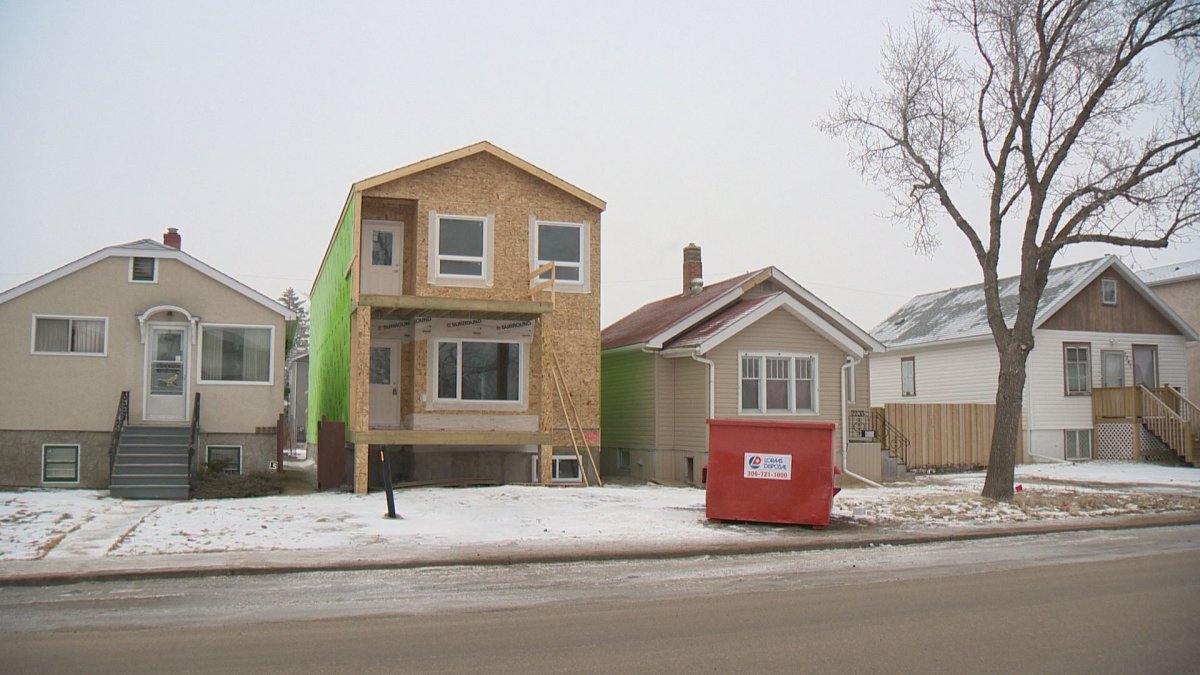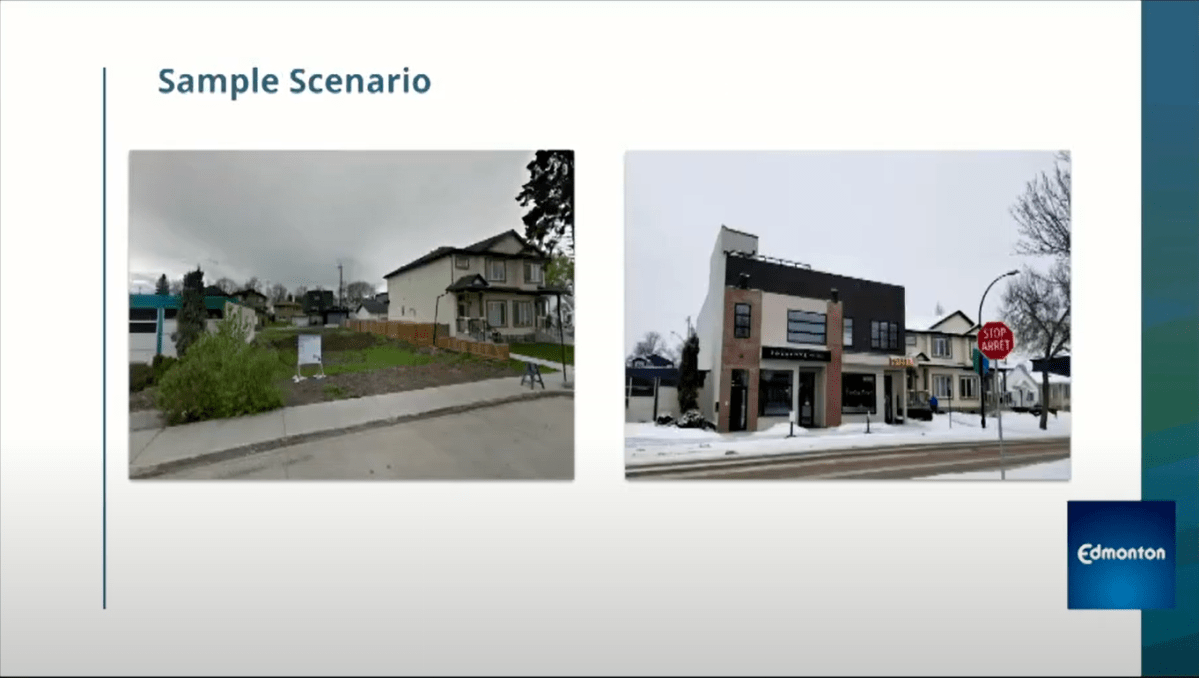Big changes could be allowed in every neighbourhood across Edmonton if city council chooses to pass a revised zoning bylaw.

The original zoning bylaw was based on the premise that Edmontonians live in one neighbourhood, work in another and shop in a third, travelling by car between them. The city says these days, many people don’t live like that and don’t want to.
The city is proposing a total overhaul to the bylaw, which hasn’t been renewed since the 1960s, that it says will make the city more vibrant, affordable, climate-friendly and economically successful.
Why you should care
As much as your eyes may start to glaze over when you read the phrase “zoning bylaw renewal,” it’s essential to be informed and get involved in this process.
That’s according to Sandeep Agrawal, director of the school of urban and regional planning at the University of Alberta.
“The zoning bylaw shapes a city. It also shapes people’s lives who live in that city,” said Agrawal.
“So it is absolutely the most important aspect of how (the City of Edmonton) regulates a community. So I think community involvement is absolutely the key, and it will empower (Edmontonians) to see how the city should be shaped around them.”
- Trudeau says ‘good luck’ to Saskatchewan premier in carbon price spat
- Canadians more likely to eat food past best-before date. What are the risks?
- Hundreds mourn 16-year-old Halifax homicide victim: ‘The youth are feeling it’
- On the ‘frontline’: Toronto-area residents hiring security firms to fight auto theft
Ward Métis councillor Ashley Salvador said the new bylaw would be the city’s primary tool when it comes to shaping the future of Edmonton.
“Land use touches really every aspect of our lives, from the types of homes that are available to us, to the types of businesses allowed in our neighbourhoods, to the park space that we have access to,” she said.
“As dry and boring as the zoning bylaw may sound, that’s how we’re going to get there. We have to have our rulebook set in the right direction.”
The proposed changes
City staff presented the draft bylaw to council Tuesday. Under the renewal, infill housing – such as skinny houses and small apartment buildings – could be built on any residential lot in the city without the builder needing to go through an approval process with the city.
The revised bylaw will also encourage certain business types, like small restaurants, cafes, child care and retail stores, to be located among houses in neighbourhoods.
They said as the city grows to a population of 2 million, we need to grow up, not out, and existing neighbourhoods will need to accommodate about 50 per cent of new homes.
To help with that, they’re paring down the existing 16 residential zones to just six.
“One way we’re proposing to enable a greater variety of small-scale residential development is by combining different housing types into a single residential use,” said Trevor Illingworth, a senior planner at the city.
“With a single residential use, zones would no longer prescribe the exact number or type of dwellings allowed on a single property. This would allow other types of living arrangements, such as supportive housing, lodging houses, as well as other forms like multi-unit housing to occur in any neighbourhood,” he said.
Dense housing will be allowed on any lot in the city, with some zones allowing infill and small apartments and some allowing highrises.
Density, affordability and equity
Building denser housing like rowhouses, duplexes, apartments and garden suites could help lower-income Edmontonians break into the housing market, according to Salvador.
“Look at some of our mature neighbourhoods right now. It’s not realistic to believe that everyone will be able to afford to buy a single-family house in a mature neighbourhood. But if we start to allow for more housing, that might be more achievable for a typical Edmontonian,” said Salvador.
“If we start to allow smaller scale apartments in good locations, that can be much more affordable and accessible for folks.”

Agrawal was asked by the city to make suggestions on how the new bylaw can be equity-focused. For him, zoning is inextricably linked to equity and human rights.
“In the 1940s, 50s and 60s, a zoning bylaw was used more as a discriminatory tool against people of minority status … So that is one of the issues with zoning bylaw.”
“Some of it has carried on. It may not be as explicit as it was back then, but implicitly, some of those discriminatory elements are there.”
“When we look at the history of zoning, it was often about keeping people out of certain areas and preserving single-family-only neighbourhoods and not allowing rental options or other housing types,” said Salvador.
“That actually ended up creating divisions along socioeconomic lines. So in many cases, restrictive zoning has actually been used to preserve and protect wealth.”
Salvador said the city must still invest in supportive bridge housing for people with complex needs.
Small commercial lots beside houses
The proposed bylaw would also allow a greater mix of types of lots in neighbourhoods.
Illingworth gave an example of a new development that was built a few years ago: a coffee shop and wellness centre that was built between an existing doctor’s office and a single-family home in the Bonnie Doon neighbourhood. Under the current bylaw, it had to be rezoned from residential to commercial.
“The rezoning process that it took to get there can be costly, time-consuming and unpredictable,” he said.
Should this draft pass, a development like this could be built on lots beside existing commercial lots across the city. Illingworth said this change will help Edmonton’s business community and contribute to the creation of communities where people can meet their needs locally within a 15-minute walk, roll or transit trip.
The changes in the bylaw will be big should it pass, but residents want them, said Mayor Amarjeet Sohi.
“I firmly believe that Edmontonians are ready to embrace this change and this is very transformative,” he said.
Sohi said this bylaw could help Edmonton create livable and affordable communities that are climate resilient and more equitable.
Ward Anirniq councillor Erin Rutherford said though it can be dry, policy like zoning is important.
“At the end of the day, policy is usually where things change. We can have as many programs and services in place, but ultimately at the end of the day, the biggest lever we have to create real systemic change is policy,” said Rutherford.

Laurie Krause is part of the Grandview Heights Community League and she said most Edmontonians don’t know these changes could be coming.
“It is alarming that most of the general public is unaware of the residential zoning being revised… Maybe there could be fewer complaints to deal with afterwards if the greater population knew what was being planned now and could fully share their thoughts to support the growth of their neighbourhood,” said Krause.
The city has engagement and education opportunities available online and in person. The proposed bylaw can be viewed in its entirety online and there is a chance to give feedback on every detail. There is also an overview document that describes the changes in much more accessible terms. The city produced a short podcast explaining the changes. The city has a map that shows what zone each property in the city is in now and what the property will be changed to under the proposed bylaw.
The current round of feedback will be open until Dec. 18. The final zoning bylaw will be implemented late next year.





Comments